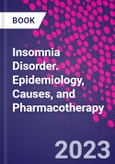Table of Contents
1. Neurobiology of sleep and waking2. Neurotransmitters and sleep
3. Regulation of sleep and wakefulness (two-process model of sleep and three-process model of alertness)
3. Chronobiotics and chronohypnotics
4. Normal sleep in children adolescents, adults, and older adults
5. Insomnia: Overview and classification
6. Insomnia characteristics in children, adolescents, adults, and older adults
7. Mechanism of action of presently available hypnotic drugs
8. Pharmacokinetics of presently available hypnotic drugs
9. Non-pharmacological treatment of an insomnia disorder
10. Benzodiazepine hypnotics
11. "Zeta drugs�: Zopiclone, Eszopiclone, Zolpidem, and Zaleplon
12. Melatonin and melatonin receptor agonists (Ramelteon, Tasimelteon)
13. Histamine H1 receptor antagonists (with special emphasis on low-dose Doxepin)
14. Orexin receptor antagonists (Suvorexant, Lemborexant)
15. Insomnia and CAM therapies: an evidence-based approach








